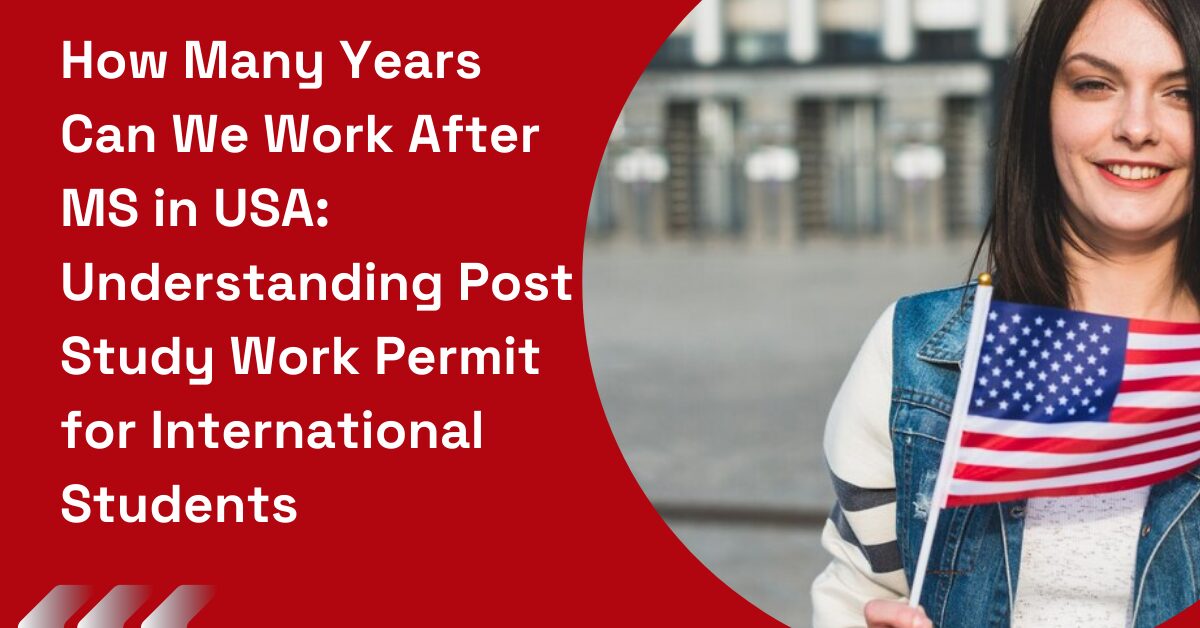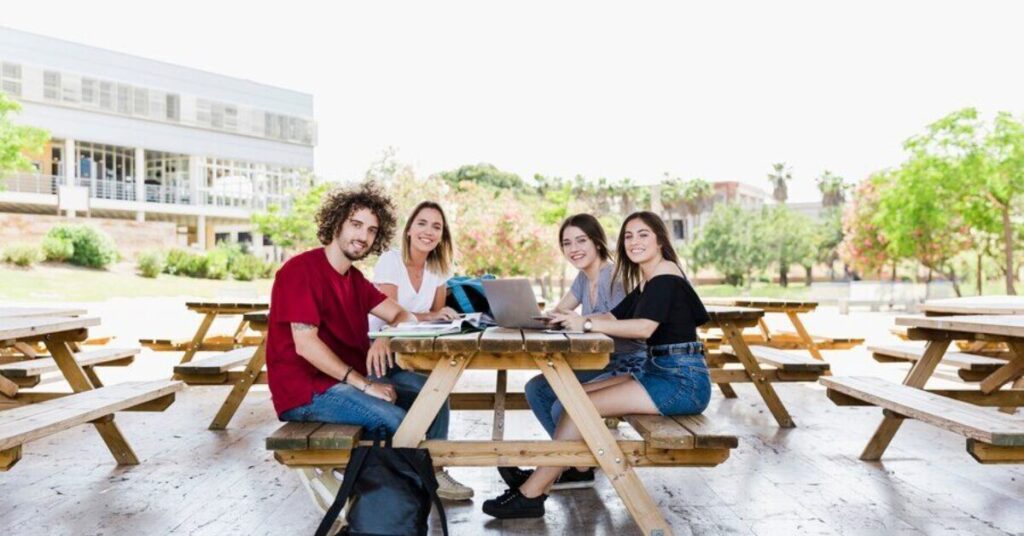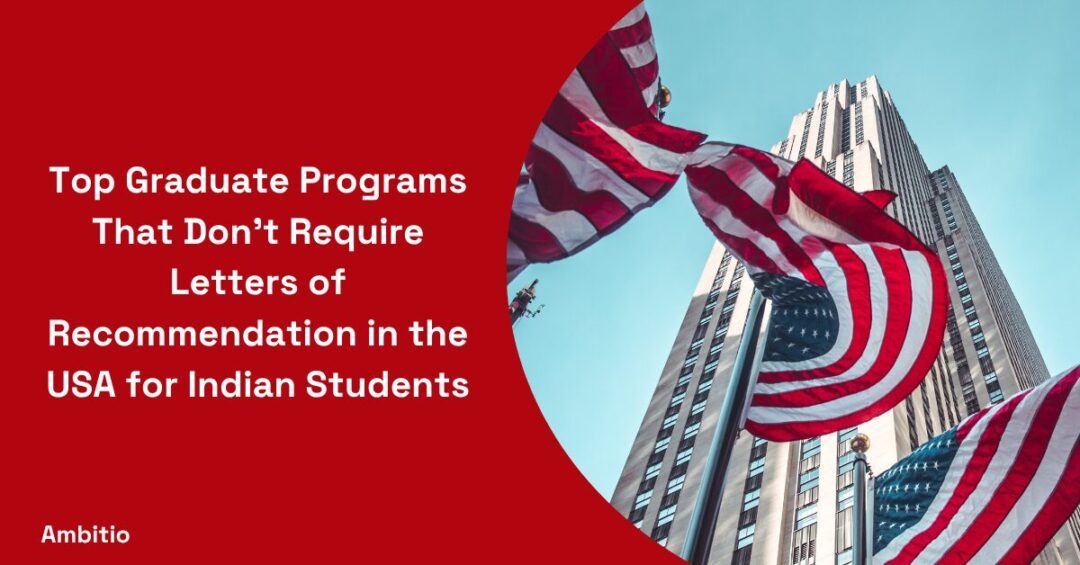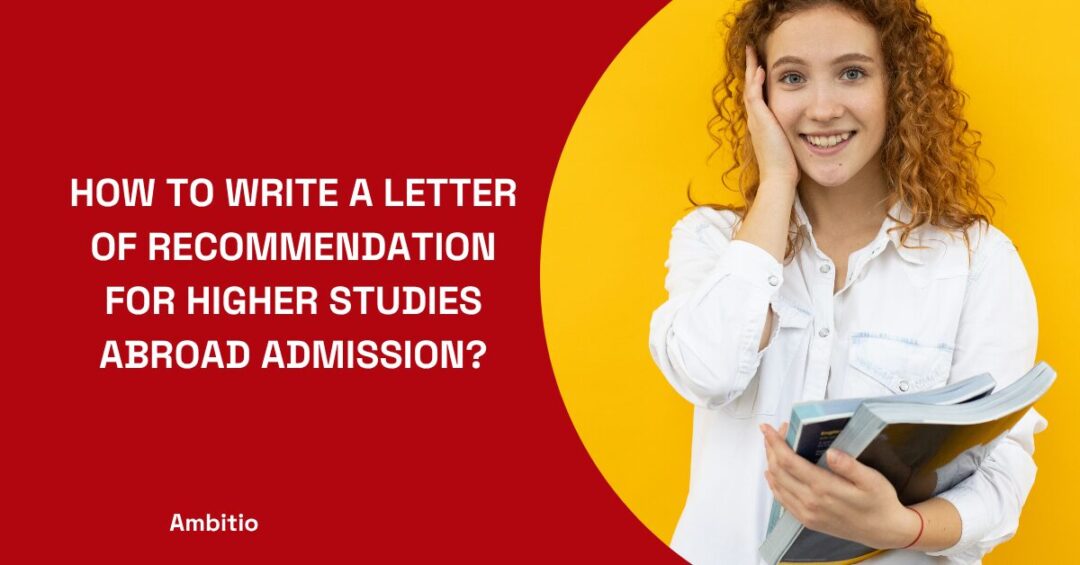11 August 2024
11 minutes read
How Many Years Can We Work After MS in USA: Understanding Post Study Work Permit for International Students

Key Takeaways
- OPT offers up to 12 months of work experience post-MS, with STEM graduates eligible for an additional 24-month extension.
- The H-1B visa pathway requires careful planning and employer sponsorship, subject to annual caps and a lottery system.
- Green card applications involve multiple steps and categories, often requiring employer support and strategic timing.
- Success in settling in the USA post-MS hinges on early preparation, maintaining legal status, and leveraging available resources.
Are you an international student dreaming of pursuing your Master’s in the USA, but unsure about your work prospects after graduation? You’re not alone. Many students grapple with questions about post-study work opportunities, visa regulations, cost of studying in USA for Indian students, how many years can we work after MS in USA and so on.
Navigating the complexities of post-study work permits can be overwhelming, especially when you’re focused on your academic goals. like doing a bachelors in USA. This blog aims to demystify the process, providing you with clear, up-to-date information on how long you can work in the USA after your MS. Choose your university well so that you can manage your expenses and life there. You can choose affordable universities in the USA for the process as well. We’ll explore the various options available, helping you plan your career path with confidence.
Post-Study Work Permit After MS in USA
After completing your MS in the USA, you have a valuable opportunity to gain work experience through a post-study work permit. This permit, known as Optional Practical Training (OPT), allows international students to work in their field of study for a specific period. If you look for post-graduate scholarships for international students in the USA, you can save a lot on the expenses and manage your work better.
OPT typically lasts for 12 months. However, if you’ve graduated with a STEM degree, you might be eligible for a 24-month extension, giving you up to 36 months of work experience. This extended period can be crucial for building your career, networking, and potentially transitioning to other long-term visa options like the H-1B.
Why is a Post-Study Work Permit Important?

A post-study work permit allows international students to seamlessly transition from academic life to professional environments. Working in the US post-graduation provides exposure to American corporate culture and work ethics. It opens doors to vast networks and career opportunities, essential for long-term professional success. If you are going for higher studies in the USA, start focusing on your GPA as well. You can seek the help of a GPA calculator for MS in USA for better and accurate results. There are many affordable masters degrees for international students in the USA, so make your choice wisely and then move on with the rest of the processes.
What is Optional Practical Training (OPT)?
Optional Practical Training (OPT) is a program that permits international students with F-1 visas to work in the USA in their field of study for up to 12 months following graduation. For those with a degree in STEM (Science, Technology, Engineering, Mathematics) fields, this can be extended by an additional 24 months, offering a total of 36 months of work experience in the USA. But students need to have a clear idea of the difference between a public and private university in USA before all this, so that they can choose the right college for themselves.
What is the Eligibility for OPT for International Students
Apart from educational eligibility like the need for an SAT to study in USA and you must be an F-1 student who has completed at least one full academic year of study in the United States. Additionally, you must apply for OPT before the end of your 60-day grace period following your program completion date.
| Criteria | Eligibility for OPT |
|---|---|
| Visa Status | Must be on an F-1 student visa |
| Educational Requirement | Enrolled in an accredited college or university |
| Duration of Study | Must have completed at least one full academic year |
| Field of Study | Any field (STEM fields qualify for an extension) |
| Job Relevance | The job must be directly related to the student’s major area of study |
| Application Timing | Up to 90 days before and 60 days after program end date |
Steps for Applying for OPT
To apply for OPT, you’ll need to submit Form I-765 to USCIS, along with supporting documents like your I-20 form and passport. Your Designated School Official (DSO) will help you through the process, which typically takes about 90 days for approval. The steps remain same for postgraduate schools in USA as well.
Step 1: Check Eligibility
Ensure you meet all the criteria for OPT, including being an F-1 student and completing one full academic year.
Step 2: Consult Your International Student Office
Before applying, consult with your school’s International Student Office for guidance and a recommendation.
Step 3: Complete Form I-765
Fill out the USCIS Form I-765, Application for Employment Authorization. Ensure all information is accurate and complete.
Step 4: Gather Required Documents
Compile documents such as your passport, I-94 record, two passport-style photos, and your most recent I-20.
Step 5: Write a Cover Letter
Include a cover letter explaining your request for OPT and how it relates to your field of study. Postgraduate study in USA can be a bit confusing for anyone who is new to the country, but OPT letter can be done the right way by asking guidance from colleagues and professors at the college.
Step 6: Pay the Application Fee
Ensure you pay the correct filing fee for the I-765 application. Check the latest fee on the USCIS website.
Step 7: Submit the Application
Mail your completed application packet to the appropriate USCIS Lockbox facility.
Step 8: Track Your Application
Once submitted, track your application status online using the receipt number provided by USCIS.
Step 9: Wait for Employment Authorization Document (EAD)
After approval, you will receive your EAD card, which is necessary to begin working.
Step 10: Report Employment to Your School
Once you secure employment, inform your International Student Office as your OPT status requires you to report your work.
Step 11: Abide by OPT Rules and Regulations
While on OPT, adhere to all rules, including working in your field of study and not exceeding the allowed period of unemployment.
Navigating the H-1B Visa Pathway

The H-1B visa is a popular option for those looking to extend their stay beyond OPT, allowing you to work for up to six years in a specialty occupation. However, it’s subject to an annual cap and a lottery system, making the application process competitive and timing crucial. Make sure to understand whether there is an age limit for bachelors study in USA before making your proceedings.
| Step | Description |
|---|---|
| Understand the H-1B Visa | Recognize that the H-1B is for temporary employment in specialty occupations in the U.S. Clear the doubt of whether you can study in the USA with a b1/b2 visa. |
| Check Eligibility Criteria | Ensure having a bachelor’s degree or equivalent and a job offer in a specialty occupation. |
| Find a Sponsoring Employer | Secure a job with a U.S. employer willing to sponsor your H-1B visa. |
| Labor Condition Application (LCA) | Employers must file an LCA with the Department of Labor for wage and working condition details. |
| Prepare the H-1B Visa Petition | File Form I-129 with the approved LCA and supporting documents. |
| Understand the Cap and Lottery System | Be aware of the annual cap and the lottery system if the number of applicants exceeds the cap. |
| Be Mindful of the Application Timeline | The application period typically begins on April 1st for the fiscal year starting October 1st. |
| Maintain Status While Waiting | If on OPT, ensure maintaining your status while your H-1B petition is pending. |
| Change of Status (COS) | If in the U.S., your employer can request a COS from F-1 to H-1B without leaving the country. |
| Prepare for Possible H-1B Interview | Depending on the situation, an interview at a U.S. Embassy or Consulate may be required. |
| Stay Informed About Visa Approval | Once approved, start working on H-1B status from October 1st or as per the approval notice. |
Tips for a Successful H-1B Visa Application
Start your H-1B application process early, ideally several months before your OPT expires, to allow for processing time and potential setbacks. Ensure that you studied at a recognized university, and stay away from blacklisted universities in USA. Work closely with your employer’s legal team to ensure all documentation is accurate and complete, as even small errors can lead to rejection. There are best universities for Indian students in the USA which you can check out.
- Start Early: Begin your H-1B application process well in advance. The cap is quickly reached, so timely preparation is crucial.
- Find the Right Employer: Look for employers known for sponsoring H-1B visas, especially those familiar with the process and willing to support your application.
- Ensure Job Matches Your Qualifications: The job offer should closely match your field of study and work experience to justify the specialty occupation requirement.
- Gather Comprehensive Documentation: Compile all necessary documents, including academic records, work experience certificates, and any relevant professional licenses or certifications.
- Accurate LCA Filing: Ensure your employer accurately completes the Labor Condition Application, detailing your role, salary, and working conditions.
- Prepare a Strong Petition: Work with your employer to prepare a compelling H-1B petition. This should include detailed job descriptions and evidence of your qualifications.
- Stay Updated on Policy Changes: Immigration policies can change. Stay informed about any updates or revisions to H-1B visa regulations.
- Consider Premium Processing: If timing is critical, consider using the USCIS Premium Processing Service for a faster response, though it involves an additional fee.
- Maintain Legal Status: If you’re in the U.S. on another visa type, maintain your legal status throughout the application process.
- Be Prepared for RFEs: If you receive a Request for Evidence (RFE), respond thoroughly and promptly with the required information.
- Plan for Multiple Attempts: Due to the lottery system, not all applications are selected. Be prepared to reapply or explore alternative visa options if necessary.
- Seek Professional Advice: If needed, consult with an immigration attorney for advice tailored to your specific situation and for assistance with complex cases.
Understanding the Green Card Process
Just like choosing the best subject to study in the USA, choosing the right time and process for the green card is also super important. The green card process, while complex and often lengthy, offers a pathway to permanent residency in the USA, typically requiring employer sponsorship or exceptional skills in your field.
| Step | Description |
|---|---|
| Green Card Basics | Grants permanent residency in the USA, allowing indefinite living and working in the country. |
| Eligibility Categories | Determine if eligible under categories like employment-based, family-sponsored, refugee, or diversity lottery. |
| Employment-Based Green Cards | Most common for students/workers; requires a job offer and employer sponsorship. |
| PERM Labor Certification | Employers may need to obtain this certification to demonstrate no suitable U.S. workers for the position. |
| File Form I-140 | Employer files this on your behalf, establishing the basis for your application. |
| Priority Date and Visa Bulletin | Monitor your priority date and Visa Bulletin for visa availability based on category and country. |
| Adjustment of Status or Consular Processing | File Form I-485 for status adjustment if in the U.S., or undergo consular processing if abroad. |
| Biometrics Appointment | Attend fingerprinting and photographing. |
| Interview and Required Documents | Prepare for an interview and gather documents like employment records and proof of legal status. |
| Receive Your Green Card | If approved, you will be granted permanent resident status in the U.S. |
Eligibility and Application Strategies
There are many reasons to study in the USA. If you choose USA for your higher studies, it is important to understand the eligibility for future work permit there. Key strategies for green card eligibility include maintaining lawful status, excelling in your field, and exploring various categories like employment-based or extraordinary ability visas. People who are still confused on what to do to study in USA can try to understand the processes clearly from authorized sites.
- Determine Your Eligibility Category: Identify which Green Card category you fit into – employment-based, family-sponsored, asylum, or diversity lottery. Each category has its specific requirements.
- Understand the Job Offer Requirement: For employment-based Green Cards, ensure you have a valid job offer from a U.S. employer willing to sponsor your application.
- Prepare a Strong Application: Compile a comprehensive application package with all required documentation, such as proof of employment, qualifications, and legal status in the U.S.
- Meet the Education/Work Experience Requirements: For most categories, you must have the equivalent of a U.S. bachelor’s degree or higher, or substantial work experience in your field.
- Seek Employer Support for PERM Labor Certification: In certain employment-based categories, your employer must complete the PERM Labor Certification process, proving that there are no suitable U.S. workers for your position.
- File the I-140 Petition Timely: Have your employer file Form I-140, Immigrant Petition for Alien Worker, as soon as possible to establish your basis for a Green Card and set your priority date.
- Keep Track of the Visa Bulletin: Regularly check the U.S. Visa Bulletin to see when a visa becomes available for your category and country of origin.
- Choose Adjustment of Status or Consular Processing: Decide whether to adjust your status in the U.S. (if applicable) or proceed through consular processing in your home country.
- Be Prepared for Delays and Setbacks: The Green Card process can be lengthy and complex. Be prepared for potential delays and respond promptly to any requests from USCIS.
- Consider Legal Assistance: Given the complexity of immigration law, consider consulting with an immigration attorney for guidance and to increase the likelihood of a successful application.
- Maintain Legal Status: Ensure you maintain your legal status in the U.S. throughout the application process, especially if you are already in the country on a different visa.
How to Settle in USA after MS

Settling in the USA after completing your MS degree requires careful planning and strategic decision-making. If you have a STEM degree, (it is best to choose a masters degree which is the most in demand in the USA) you’re already at an advantage, as it opens up more opportunities for extended work authorization. If you would choose the top public universities in the USA for your studies, it makes things even more easier. The first step is typically to secure Optional Practical Training (OPT), which allows you to work in your field of study for up to 12 months. STEM graduates can potentially extend this to 36 months, giving you valuable time to establish yourself professionally.
During your OPT period, it’s crucial to focus on building your career and exploring long-term visa options. Many international students aim for the H-1B visa, which allows you to work in a specialty occupation for up to six years. However, the H-1B process is competitive, so it’s wise to start early and work closely with your employer. Alternatively, you might consider other visa categories that align with your skills and career goals. Throughout this journey, maintaining valid immigration status is paramount. Stay informed about visa regulations, meet all deadlines, and consider consulting with an immigration attorney to navigate the complex landscape of visas in the USA.
Conclusion
Embarking on the journey of post-study work in the USA marks a significant milestone for international students. This experience not only enhances your professional skills but also immerses you in a diverse cultural landscape, offering a broader perspective on both your career and life. While navigating the visa processes and work permit regulations may seem daunting, proper planning and adherence to guidelines can lead to a rewarding post-graduate work experience. Remember, the key to success lies in early preparation, staying informed, and utilizing the resources available to you. Embrace this opportunity to grow, network, and lay a strong foundation for your future career.
Explore endless possibilities and find your perfect course match with Ambitio’s Course Finder. Whether you’re looking to advance your career or pursue new academic horizons, our tool provides personalized recommendations to guide you toward the right educational journey.
FAQs
How long can I work in the USA after completing my MS degree?
After completing your MS degree in the USA, you typically have the opportunity to work for 12 months under the Optional Practical Training (OPT) program. This allows you to gain valuable work experience in your field of study. However, if you have graduated with a STEM degree, you may be eligible for a significant extension. STEM OPT offers an additional 24 months, bringing your total potential work period to 36 months. This extended timeframe can be crucial for building your career and exploring long-term visa options. After your OPT period, you might consider transitioning to other visa categories, such as the H-1B, which could allow you to work in the USA for up to 6 years, subject to approval and annual caps
Is it possible to switch from an F-1 student visa to a work visa in the USA?
Yes, students often transition from an F-1 visa to an H-1B work visa after their OPT.
Can I apply for a work permit after completing an MBA in the USA?
Yes, MBA graduates are eligible for OPT, allowing them to work in the USA for up to 12 months post-graduation.
What are the requirements for the STEM OPT extension?
You must have a STEM degree, be on valid OPT, and have a job offer from an employer enrolled in E-Verify.
How early should I apply for OPT?
It’s advisable to apply up to 90 days before and up to 60 days after your program’s end date.
What are the key steps to apply for an H-1B visa after my OPT period?
Applying for an H-1B visa after your OPT period involves several crucial steps. First, you’ll need to secure a job offer from an employer willing to sponsor your H-1B petition. Your employer will then need to file a Labor Condition Application (LCA) with the Department of Labor, certifying that hiring you won’t adversely affect U.S. workers. Once the LCA is approved, your employer can submit the H-1B petition (Form I-129) on your behalf, along with supporting documents. It’s important to be aware of the annual cap on H-1B visas and the lottery system used when applications exceed this cap. The application period typically opens on April 1st for the fiscal year starting October 1st, so timing is crucial. Throughout this process, you must maintain your current visa status. Given the competitive nature of H-1B visas, it’s advisable to start the process early and work closely with your employer’s legal team to ensure a strong application.

You can study at top universities worldwide!
Get expert tips and tricks to get into top universities with a free expert session.
Book Your Free 30-Minute Session Now! Book a call now




























